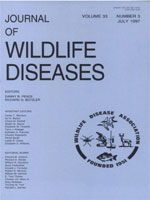Following a severe infectious keratoconjunctivitis (IKC) epizootic in free-ranging alpine ibex (Capra ibex ibex) in Switzerland in 1993, 19 animals were examined from six different populations. Mucopurulent exudates, reddened conjunctiva and mononuclear inflammatory cell infiltration in the conjunctiva and the limbic area were observed in mild cases. In more severe cases, lesions ranged from perilimbic neovascularization to corneal edema, erosion, ulceration and neovascularization accompanied by infiltration of neutrophils. Sometimes an iridocyclitis was observed. In the most advanced stages, the cornea was perforated and an anterior synechia was present. Lesions found in ibex affected with IKC indicated a non-generalized, specific ocular disease. The other organs investigated did not show alterations suggestive of changes induced by agents which might cause IKC, including Chlamydia spp. and Mycoplasma, spp. The microbiological findings indicate that Mycoplasma conjunctivae is the primary pathogenic agent causing IKC in this species in Switzerland.
How to translate text using browser tools
1 July 1997
LESIONS ASSOCIATED WITH INFECTIOUS KERATOCONJUNCTIVITIS IN ALPINE IBEX
Daniel Mayer,
Marie-Pierre Degiorgis,
Willy Meier,
Jacques Nicolet,
Marco Giacometti

Journal of Wildlife Diseases
Vol. 33 • No. 3
July 1997
Vol. 33 • No. 3
July 1997
Alpine ibex
Capra ibex ibex
Histology
infectious keratoconjunctivitis
Mycoplasma conjunctivae
pathology




